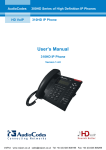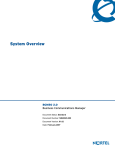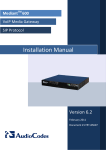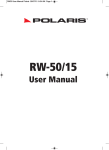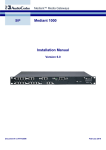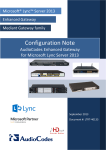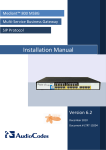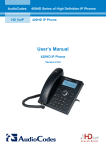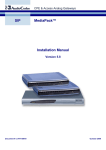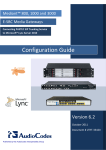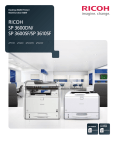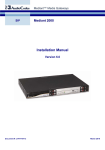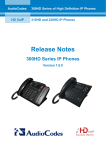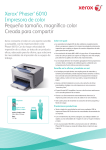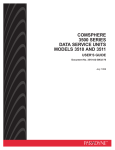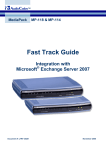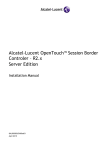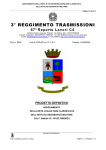Download Alcatel-Lucent OpenTouch™ Session Border Controler – R2.x
Transcript
Alcatel-Lucent OpenTouch™ Session Border
Controler – R2.x
Recommended Security Guidelines Configuration Note
8AL90063USABed01
April 2015
Alcatel-Lucent OpenTouch™ Session Border Controler
Recommended Security Guidelines Configuration Note
Table of Contents
1.
2.
Introduction ........................................................................................................................................................ 5
1.1
Security Threats .................................................................................................................................................. 5
1.2
AudioCodes Security Solution ............................................................................................................................. 6
Separate Network Traffic .................................................................................................................................... 7
2.1
Identify Trusted and Un-trusted Networks ......................................................................................................... 7
2.2
Use VLANs to Separate LAN Traffic .................................................................................................................... 7
2.3
Implement Physical Network Separation using Ethernet Port Groups ............................................................... 8
2.4
Implement Physical Network Separation (Mediant 3000) ................................................................................. 9
2.5
Data-Router Specific Security Guidelines .......................................................................................................... 10
Use VLANs and VRFs to Separate WAN Traffic ......................................................................................................... 10
Use Port VLANs (PVID) to Physically Separate LAN Traffic ........................................................................................ 10
3.
Implement Layer 3/4 (Network) Firewall............................................................................................................11
3.1
Block Unused Network Ports ............................................................................................................................ 11
3.2
Define VoIP Traffic Firewall Rules ..................................................................................................................... 11
3.3
Define Data-Routing Firewall Rules for WAN ................................................................................................... 13
Avoid Creation of DMZ Host ..................................................................................................................................... 13
Define Explicit Access List Rules ................................................................................................................................ 13
4.
Secure Management Access ...............................................................................................................................15
4.1
Change Default Management User Login Passwords ...................................................................................... 15
4.2
Implement LDAP-based User Authentication and Authorization ..................................................................... 16
4.3
Implement RADIUS-based User Authentication ............................................................................................... 16
4.4
Implement Two-Way Authentication with X.509 Certificates .......................................................................... 17
4.5
Secure HTTP Access using HTTPS ...................................................................................................................... 18
4.6
Secure Telnet Sessions ...................................................................................................................................... 18
4.7
Secure SSH Sessions .......................................................................................................................................... 19
4.8
Define Web, Telnet, and SSH Authorized Access List ........................................................................................ 20
4.9
Secure SNMP Interface Access.......................................................................................................................... 21
Prefer SNMPv3 over SNMPv2 ................................................................................................................................... 21
Secure SMNPv2 Access ............................................................................................................................................. 21
Secure LDAP Communication .................................................................................................................................... 23
5.
6.
Secure SIP using TLS (SIPS) .................................................................................................................................24
5.1
Use Strong Authentication Passwords.............................................................................................................. 24
5.2
Use TLS Version 1.0 Only .................................................................................................................................. 24
5.3
Use TLS for SIP Interfaces and Block TCP/UDP Ports ........................................................................................ 25
5.4
Use TLS for Routing Rules ................................................................................................................................. 25
5.5
Implement X.509 Certificates for SIPS (TLS) Sessions ....................................................................................... 26
5.6
Use an NTP Server ............................................................................................................................................ 26
Version 6.6
August 2014
Define Maximum Call Duration ..........................................................................................................................27
April
2013 # LTRT-30204
Document
Document # LTRT-30203
8AL 90063 USAB ed01
2 /46
Alcatel-Lucent OpenTouch™ Session Border Controler
Recommended Security Guidelines Configuration Note
7.
Define SIP Message Blacklist/Whitelist ..............................................................................................................28
8.
Monitor and Log Events .....................................................................................................................................29
8.1
Implement Dynamic Blacklisting of Malicious Activity (IDS) ............................................................................ 29
8.2
Enable Syslog .................................................................................................................................................... 30
8.3
Enable Logging of Management-Related Events ............................................................................................. 30
8.4
Enable Call Detail Records ................................................................................................................................ 31
9.
SBC-Specific Security Guidelines .........................................................................................................................32
9.1
General Guidelines ........................................................................................................................................... 32
9.2
Secure Media (RTP) Traffic using SRTP ............................................................................................................. 32
9.3
Implement SIP Authentication and Encryption ................................................................................................. 33
Authenticating Users as an Authentication Server ................................................................................................... 33
Authenticating Users by RADIUS Server ................................................................................................................... 35
Authenticating SIP Servers as an Authentication Server ........................................................................................... 35
Enforce SIP Client Authentication by SIP Proxy ......................................................................................................... 35
Enforce SIP Digest Authentication by IP PBX ............................................................................................................ 35
9.4
Secure Routing Rules ........................................................................................................................................ 36
Define Strict Classification Rules ............................................................................................................................... 36
Allow Calls only with Specific SIP User-Agent Header Value .................................................................................... 37
Block Unclassified Calls ............................................................................................................................................. 38
Disable the Classify by Proxy Set Feature ................................................................................................................. 38
Define Strict Routing Rules ....................................................................................................................................... 39
9.5
Define Call Admission Control Rules ................................................................................................................. 39
9.6
Secure SIP User Agent Registration .................................................................................................................. 40
Configure Identical Registration Intervals ................................................................................................................. 40
Limit SBC Registered Users per IP Group / SRD ........................................................................................................ 41
Block Calls from Unregistered Users ......................................................................................................................... 41
Block Registration from Un-Authenticated Users ..................................................................................................... 42
9.7
Authenticate BYE Messages ............................................................................................................................. 42
9.8
Use SIP Message Manipulation for Topology Hiding........................................................................................ 43
10.
Gateway-Specific Security Guidelines ............................................................................................................44
10.1
Block Calls from Unknown IP Addresses ........................................................................................................... 44
10.2
Enable Secure SIP (SIPS).................................................................................................................................... 44
10.3
Define Strict Routing Rules ............................................................................................................................... 45
10.4
Define Call Admission Control .......................................................................................................................... 45
8AL 90063 USAB ed01
3 /46
Alcatel-Lucent OpenTouch™ Session Border Controler
Recommended Security Guidelines Configuration Note
Notice
This document describes the recommended security guidelines for AudioCodes Mediant Series
devices.
Information contained in this document is believed to be accurate and reliable at the time of printing.
However, due to ongoing product improvements and revisions, AudioCodes cannot guarantee
accuracy of printed material after the Date Published nor can it accept responsibility for errors or
omissions. Updates to this document and other documents as well as software files can be viewed by
registered customers at http://www.audiocodes.com/downloads.
© Copyright 2014 AudioCodes Ltd. All rights reserved.
This document is subject to change without notice.
Date Published: August-27-2014
Trademarks
AudioCodes, AC, AudioCoded, Ardito, CTI2, CTI², CTI Squared, HD VoIP, HD VoIP Sounds
Better, InTouch, IPmedia, Mediant, MediaPack, NetCoder, Netrake, Nuera, Open Solutions
Network, OSN, Stretto, TrunkPack, VMAS, VoicePacketizer, VoIPerfect, VoIPerfectHD, What's
Inside Matters, Your Gateway To VoIP and 3GX are trademarks or registered trademarks of
AudioCodes Limited. All other products or trademarks are property of their respective owners.
Product specifications are subject to change without notice.
WEEE EU Directive
Pursuant to the WEEE EU Directive, electronic and electrical waste must not be disposed of with
unsorted waste. Please contact your local recycling authority for disposal of this product.
Customer Support
Customer technical support and services are provided by AudioCodes or by an authorized
AudioCodes Service Partner. For more information on how to buy technical support for
AudioCodes products and for contact information, please visit our Web site at
www.audiocodes.com/support.
Abbreviations and Terminology
Each abbreviation, unless widely used, is spelled out in full when first used.
Throughout this manual, unless otherwise specified, the term device refers to AudioCodes
products.
Documentation Feedback
AudioCodes continually strives to produce high quality documentation. If you have any comments
(suggestions or errors) regarding this document, please fill out the Documentation Feedback form
on our Web site at http://www.audiocodes.com/downloads.
8AL 90063 USAB ed01
4 /46
Alcatel-Lucent OpenTouch™ Session Border Controler
Recommended Security Guidelines Configuration Note
1.
Introduction
This document provides recommended security guidelines for safeguarding your network and your
AudioCodes device against malicious attacks.
Notes:
This document provides only recommended security guidelines; your network architecture
may require additional and/or different security measures.
This document includes partial configuration; for detailed configuration, refer to the device's
User's Manual.
1.1
Security Threats
AudioCodes devices are commonly located at the demarcation point between safe (trusted) and
unsafe (un-trusted) networks. A typical example of an un-trusted network would be a SIP trunk
connected to an Internet Telephony Service Provider (ITSP) network while the internal LAN would
be the trusted network. The figure below illustrates the basic concept of trusted and un-trusted
networks.
Figure 1: Trusted and Un-trusted Networks
Attacks on your network from the un-trusted network may include the following:
Denial of Service (DoS) attacks: Malicious attacks designed to cripple your VoIP network
by overloading it with calls or service requests.
Overload events: In addition to purposeful DoS attacks, non-malicious periods of intense
activity can also cause an increase in call signaling rates that exceed what your infrastructure
can support, resulting in network conditions that are similar in effect to DoS attacks.
Successful attacks resulting in contact center downtime can result in lost revenue and
diminished customer satisfaction.
8AL 90063 USAB ed01
5 /46
Alcatel-Lucent OpenTouch™ Session Border Controler
Recommended Security Guidelines Configuration Note
Network abuse and fraud: Malicious intrusion or service theft may take the form of an
unauthorized user gaining access to your VoIP network by mimicking an authorized user or
seizing control of a SIP proxy and initiating outbound calls to the PSTN for free. Another
possibility is using a compromised endpoint to redirect or forward calls for eavesdropping.
Viruses and malware: Computer viruses, worms, Trojan horses, and other malware can
infect user agent phones and SIP-based ACD infrastructure - just as they can computers and
servers - and degrade performance or completely disrupt service. As devices become more
sophisticated with distinct operating systems, malware also serves as a way to subjugate
devices and launch DoS attacks that piggyback encrypted links.
Identity theft: Phishing and "man-in-the-middle" can be used to acquire caller identification
information to gain unauthorized access to services and information. Theft by phone (or
service theft), whereby access to your corporate phone system is attempted by users posing
as legitimate ones can sky-rocket your corporation's phone bill.
Eavesdropping: The ability to listen to or record calls is easier on VoIP networks than on
PSTN. This is a concern not only because of personal privacy violations, but also because
sensitive information can be compromised and exploited.
Spam over Internet Telephony (SPIT): The delivery of unsolicited calls or voicemails can
inundate networks, annoy subscribers, and diminish the usefulness of VoIP networks.
These threats exist, for example, at the following main IP network border points:
Interconnect: SIP trunks to ITSPs, using SIP signaling for inbound and outbound calls.
Trusted access: Private, managed IP networks that connect service providers' residential,
enterprise, or mobile subscribers (as part of an emerging federation of trusted networks).
Un-trusted access: Unmanaged Internet for connections to work-at-home agents or inbound
callers.
1.2 AudioCodes Security Solution
The AudioCodes device provides a comprehensive package of security features that handles the
following two main security areas:
Securing the Service: Secures the call services it provides by implementing separation and
defense of different network entities (e.g., SIP Trunk, softswitch, and users). This is
accomplished by the following:
Physical separation of networks
SRDs for each entity
IP Groups per entity
Securing the Device Itself: This concerns two areas:
Management – ensuring that only authorized users can access the device's
management interface
Defense against attacks on the device regarding SIP signaling and media (RTP)
Due to the vast number and types of potential attacks (some described in the previous section),
security of your trusted VoIP network should be your paramount concern. The AudioCodes device
provides a rich set of features to support perimeter defense for protecting your trusted network
from the un-trusted ones. However, the device's security features and capabilities are only
effective if implemented correctly. Improper use of the device for perimeter defense may render
the overall security solution ineffective, thereby exposing your network to multiple threats.
The benefits of an IP-based telephony network are quite clear, but so are the threats and security
implications that need to be addressed. The IP borders of the IP telephony network are the attack
points and it is the AudioCodes security solutions that are designed to help safeguard your trusted
network from such threats.
8AL 90063 USAB ed01
6 /46
Alcatel-Lucent OpenTouch™ Session Border Controler
Recommended Security Guidelines Configuration Note
2.
Separate Network Traffic
This section provides recommendations for separating network traffic.
2.1
Identify Trusted and Un-trusted Networks
It is crucial that you identify the trusted network (i.e., your local LAN) and un-trusted network (i.e.,
public Internet – WAN) in the environment in which the device is deployed (for an example
illustration of such an architecture, see Figure 1 on page 5). There may be multiples of each. For
example, far-end users and a SIP trunk with an ITSP may represent two un-trusted networks.
Once identified, you need to handle the un-trusted networks with extreme caution to safeguard
your trusted network from malicious attacks from it. One of the main precautions is to separate
your trusted network from the un-trusted network using different logical configuration entities such
as SRDs etc. The precautions and security guidelines are described in detail in subsequent
sections.
2.2
Use VLANs to Separate LAN Traffic
Note: This section is applicable only to MP-11x, Mediant MSBR Series, Mediant 2000, and
Mediant 3000.
It is recommended to implement virtual LANs (VLAN) to separate OAMP, media, and SIP
signaling traffic on the LAN. VLANs may increase security in your network. VLANs are configured
for the device's network interfaces in the Interface table (Configuration tab > VoIP > Network >
IP Interfaces Table), as shown below:
MP-1xx; Mediant 2000; Mediant 3000:
Figure 2-1: VLANs in Interface Table
Mediant MSBR Series:
Figure 2-2: Configuring VLAN IDs in Ethernet Device Table
8AL 90063 USAB ed01
7 /46
Alcatel-Lucent OpenTouch™ Session Border Controler
Recommended Security Guidelines Configuration Note
Figure 2-3: Assigning VLANs (Underlying Devices) to Interfaces in Interface Table
2.3
Implement Physical Network Separation using Ethernet Port Groups
Note: This section is applicable only to Mediant 500 Gateway & SBC, Mediant 800 Gateway
& SBC, Mediant 1000B Gateway & SBC, Mediant 2600 E-SBC, Mediant 4000 SBC, Mediant
9000 SBC, and Mediant Software SBC.
For some devices (see note above), the network traffic can be physically separated by Ethernet
ports, using Ethernet Port Groups. Each Ethernet Port Group can include up to two physical
Ethernet ports. The Ethernet Device defines the VLAN per Ethernet Port Group. The Ethernet
Device is then assigned to the network interface as an Underlying Device. The below show
examples of such a configuration.
Figure 2-4: Assigning Ports to Ethernet Groups in Ethernet Group Settings Table
Figure 2-5: Assigning VLANs to Ethernet Groups in Ethernet Device Table
8AL 90063 USAB ed01
8 /46
Alcatel-Lucent OpenTouch™ Session Border Controler
Recommended Security Guidelines Configuration Note
Figure 2-6: Assigning VLANs (Underlying Devices) to Interfaces in Interface Table
2.4
Implement Physical Network Separation (Mediant 3000)
Note: This section is applicable only to Mediant 3000 with the TP-8410 blade.
It is highly recommended to separate traffic (i.e., OAMP, call control / SIP messages, and RTP
media) so that each has its own dedicated physical Ethernet port. This Physical Network
Separation feature eliminates the need for a VLAN-aware switch using VLAN tags to separate the
different traffic of each network.
The physical interface provided for each network application type is as follows:
Media: provided by the Gigabit Ethernet port on the RTM-8410
Control (SIP): provide by 10/100BaseT Ethernet ports labeled 1A (lower PEM module) and
1B (upper PEM module) – two PEMs are used for redundancy
OAMP: provided by 10/100BaseT Ethernet ports labeled 2A (lower PEM module) and 2B
(upper PEM module) - two PEMs are used for redundancy
To enable this feature, the 'Network Physical Separation' parameter in the Interface table must be
set to Enable.
Figure 2-7: Enabling Network Physical Separation in Interface Table
8AL 90063 USAB ed01
9 /46
Alcatel-Lucent OpenTouch™ Session Border Controler
Recommended Security Guidelines Configuration Note
2.5
Data-Router Specific Security Guidelines
Note: This section is applicable only to the MSBR series.
Use VLANs and VRFs to Separate WAN Traffic
It is recommended to implement the device's Virtual Routing and Forwarding (VRF) feature to
segregate VoIP (SIP and media) / OAMP traffic from data-routing traffic into routing domains on
the WAN interface. This is achieved by using the following CLI commands:
ip vrf, ip vrf forwarding
ip route vrf
Below shows a basic example for creating two VFRs, one for VoIP / OAMP ("VOIP") and one for
data ("DATA"):
(config-data)# ip vrf VOIP
(conf-if-VLAN 200)# ip vrf forwarding VOIP
(config-data)# ip route vrf VOIP 10.1.1.1 255.255.0.0 10.8.0.1 vlan 200
(config-data)# ip vrf DATA
(conf-if-VLAN 300)# ip vrf forwarding DATA
(config-data)# ip route vrf VOIP 10.1.1.1 255.255.0.0 10.8.0.1 vlan 300
Use Port VLANs (PVID) to Physically Separate LAN Traffic
You can also separate the LAN traffic you configured in the Interface table between physical LAN
ports, using port VLANs (PVID).
8AL 90063 USAB ed01
10 /46
Alcatel-Lucent OpenTouch™ Session Border Controler
Recommended Security Guidelines Configuration Note
3.
Implement Layer 3/4 (Network) Firewall
This section discusses Layer 3/4 (Network) firewall recommendations. By default, there are no
firewall rules and this exposes the device to security risks. Therefore, configuring firewall rules is
highly recommended to protect the device from external attacks.
3.1
Block Unused Network Ports
It is highly recommended that you disable network ports that are not used in your deployment. For
example, if you are not using Trivial File Transfer Protocol (TFTP) in your network, then you
should disable this network port application.
3.2
Define VoIP Traffic Firewall Rules
For packets whose source IP addresses are known, it is recommended to define VoIP firewall
rules that allow receipt of calls or packets from this network and block all calls from elsewhere.
These rules can be defined per source IP address, port, protocol, and network IP interface. If an
incoming packet is received from an invalid source (as defined in the firewall), the call or packet is
discarded.
Note: For devices with LAN and WAN interface ports (i.e., MSBR series), it is more important
that a firewall be configured for the WAN interface, which is exposed to the public network (i.e.,
Internet). For more information, see Section 3.3.
Below is a list of recommended guidelines when configuring the VoIP firewall:
Add firewall rules per network interface: It is recommended to define firewall rules for
packets from source IP addresses received on the OAMP interface and each SIP Control
(SIP) interface (defined in the Multiple Interface table). A less recommended alternative is to
define a single rule that applies to all interfaces (by setting the 'Use Specific Interface'
parameter to 'Disable').
Define bandwidth limitation per rule: For each IP network interface, it is advised to define
a rate-limiting value (byte rate, burst bytes and maximum packet size). Bandwidth limitation
prevents overloading (flooding) of your network and thereby, helps in preventing attacks such
as DoS on your device (on each network).
Define rules as specific as possible: Define the rules as detailed as possible so that they
block only the intended traffic.
Add an ICMP firewall rule: ICMP is typically used for pinging. However, malicious attackers
can send over-sized (floods) ICMP packets to a specific network address. Therefore, it is
recommended to define a rule for limiting these packets.
Add a rule to block all traffic: You must define a firewall rule that blocks all incoming traffic
(i.e., block all protocol traffic from all source IP addresses and ports for all interfaces). This
rule must be the last rule listed in the table, so that rules above it that allow specific traffic are
valid (otherwise, all traffic is blocked).
Warning: If the 'Prefix Length' field on the Firewall Settings page is set to "0", the rule
will apply to all IP addresses, regardless of whether an IP address is specified in the
'Source IP' field. Thus, if you need to apply a rule to a specific IP address, ensure that
you also set the 'Prefix Length' field to a value other than "0".
8AL 90063 USAB ed01
11 /46
Alcatel-Lucent OpenTouch™ Session Border Controler
Recommended Security Guidelines Configuration Note
The Layer 3-4 VoIP traffic firewall rules are configured on the Firewall Settings page
(Configuration tab > VoIP menu > Security > Firewall Settings). The figure below shows an
example of the following firewall rules:
Rules 1 and 2: Typical firewall rules that allow packets ONLY from specified IP addresses
(e.g., proxy servers). Note that the prefix length is configured.
Rule 3: A more "advanced” firewall rule - bandwidth rule for ICMP, which allows a maximum
bandwidth of 40,000 bytes/sec with an additional allowance of 50,000 bytes. If, for example,
the actual traffic rate is 45,000 bytes/sec, then this allowance would be consumed within 10
seconds, after which all traffic exceeding the allocated 40,000 bytes/sec is dropped. If the
actual traffic rate then slowed to 30,000 bytes/sec, the allowance would be replenished within
5 seconds.
Rule 4: Allows traffic from the LAN voice interface and limits bandwidth.
Rule 5: Blocks all other traffic.
Figure 3-1: Layer 3-4 VoIP Traffic Firewall Rules in Firewall Settings Page
Firewall Rule Settings
Value per Rule
Parameter
1
2
3
4
5
Source IP
12.194.231.76
12.194.230.7
0.0.0.0
192.0.0.0
0.0.0.0
Prefix Length
16
16
0
8
0
Start Port and End Port
0-65535
0-65535
0-65535
0-65535
0-65535
Protocol
Any
Any
icmp
Any
Any
Use Specific Interface
Enable
Enable
Disable
Enable
Disable
Interface Name
WAN
WAN
None
Voice
None
Byte Rate
0
0
40000
40000
0
Burst Bytes
0
0
50000
50000
0
Action Upon Match
Allow
Allow
Allow
Allow
Block
8AL 90063 USAB ed01
12 /46
Alcatel-Lucent OpenTouch™ Session Border Controler
Recommended Security Guidelines Configuration Note
3.3
Define Data-Routing Firewall Rules for WAN
Note: This section is applicable only to the MSBR series and if you are using the WAN
interface.
The device provides two main network interfaces. The LAN which is the internal, private network
of your enterprise, and the WAN which is the public network (Internet). Since the WAN interface is
your LAN's "door" to the public network, you must define data-routing firewall rules for the WAN
interface to prevent unwanted access from this unsafe, public network. The data-routing firewall
rules are relevant for application protocols that are used by VoIP networks such as DHCP and
TFTP. For example, firewall rules can be applied to configuration file downloads from a TFTP
server that is located in the un-trusted network, by SIP user agents (e.g., IP phones) located in the
trusted network.
This section discusses the guidelines for securing the device's WAN interface using the datarouting firewall capabilities.
Avoid Creation of DMZ Host
It is recommended not to configure a demilitarized zone (DMZ) host. The DMZ host allows a single
local computer to be exposed to all services on the Internet, without any restrictions. A DMZ host
is not protected by the firewall and may be vulnerable to attack. Designating a DMZ host may also
put other equipment in the network at risk. When designating a DMZ host, you must consider the
security implications and protect it if necessary.
Define Explicit Access List Rules
If your enterprise wishes to use the device's data-routing functionality, for example, a DCHP
server (for distributing IP addresses to the enterprise's IP phones connected through the LAN
switch), it is recommended that you define Access List rules (ACL) for blocking (deny) and
allowing (permit) specified ingress (inbound) traffic from the public IP network on the WAN
interface. If not defined, the device accepts all traffic.
Note: If your device is deployed solely as an SBC (VoIP functionality) without using the datarouter functionality, ACL rules are unnecessary. This is due to the device's automatic NAT /
port forwarding feature, which ensures that only desired traffic is allowed into the network.
You must define ACL rules as explicitly as possible:
Include as much information as possible for each rule. For example, if you want to allow RTP
traffic from only a specific IP address (e.g., 1.1.1.3), in addition to the IP address, you should
also specify the allowed destination port (e.g., 6000-8000).
Define adjacent rules (or overlapping rules) to block unwanted incoming traffic that may "slip"
through an already defined allowed rule. For example, if the rule mentioned above is defined,
unwanted RTP packets from IP address 1.1.1.3 destined to port 6600-6700 will also be
allowed. Therefore, to block this traffic, define another rule explicitly denying traffic to port
6600-6700.
Define rules to suite your environment so that only the required, minimum traffic is allowed
(while all others are blocked).
Note: Incoming traffic that does not match any ACL rule is discarded even if a rule has not
been defined to deny it (and no matching with an allowed rule exists where it can "slip"
through).
8AL 90063 USAB ed01
13 /46
Alcatel-Lucent OpenTouch™ Session Border Controler
Recommended Security Guidelines Configuration Note
Below shows an example of configured ACL rules called "WAN Firewall":
Allow HTTPS traffic from IP address 1.1.1.1 and destined to port 443:
(config-data)# access-list wan-firewall permit tcp host 1.1.1.1 any
eq 443
Allow SSH traffic from IP address 1.1.1.1 and destined to port 22:
(config-data)# access-list wan-firewall permit tcp host 1.1.1.1 any
eq 22
Block all UDP traffic from IP address 1.1.1.3 destined to port 6600-6700. This is an "adjacent"
rule for the rule below to prevent undesired traffic from "slipping" through:
(config-data)# access-list wan-firewall deny udp host 1.1.1.1 any
range 6600 6700
Allow UDP (RTP) traffic from IP address 1.1.1.3 and destined to port 6000-8000:
(config-data)# access-list wan-firewall permit udp host 1.1.1.1 any
range 6000 8000
To associate the ACL with an interface (e.g., Gigabit WAN Ethernet):
(config-data)# interface GigabitEthernet 0/0
(conf-if-GE 0/0)# ip access-group wan-firewall in
(conf-if-GE 0/0)# exit
8AL 90063 USAB ed01
14 /46
Alcatel-Lucent OpenTouch™ Session Border Controler
Recommended Security Guidelines Configuration Note
4.
Secure Management Access
This section provides guidelines to secure access to the device's management interface.
4.1
Change Default Management User Login Passwords
To secure access to the device's Web management interface, please adhere to the following
recommended guidelines:
The device is shipped with a default Security Administrator access-level user account,
"Admin" username. This user has full access and write privileges to the device. The default
login password is "Admin". Change this to a hard-to-hack string. The login username and
password are configured on the Web User Accounts page (Configuration tab > System >
Web User Accounts) using the 'Current Password', 'New Password', and 'Confirm New
Password' fields, as shown below:
Figure 2: Changing Password of Default Security Administrator User
The device is shipped with a default Monitor access-level user account, "User" username.
This user only has read access privileges to the device. The read access privilege is also
limited to certain Web pages. However, this user can view certain SIP settings such as proxy
server addresses. Therefore, in order to prevent an attacker from obtaining sensitive SIP
settings that could result in possible call theft etc., change the access level of this user to No
Access (see figure below). In addition (or alternatively), change its default login password
("User") to a hard-to-hack string.
Figure 3: Changing Access Level to No Access of Default Monitor User
If you have deployed multiple devices, use a unique password for each device.
Change the login password periodically (for example, once a month).
8AL 90063 USAB ed01
15 /46
Alcatel-Lucent OpenTouch™ Session Border Controler
Recommended Security Guidelines Configuration Note
4.2
Implement LDAP-based User Authentication and Authorization
It is highly recommended that you implement a third-party, LDAP server in your network for
authenticating and authorizing the device's management users (Web and CLI). This can be done
by using an LDAP-compliant server such as Microsoft Active Directory (AD). When a user
attempts to log in to one of the management platforms, the device verifies the login username and
password with AD. The device can also determine the user's management access level
(privileges) based on the user's profile in the AD. This is configured in the LDAP Configuration
table (Configuration tab > VoIP menu > Services > LDAP > LDAP Configuration Table).
Figure 4: LDAP Configuration Table for LDAP-Based User Authentication
An alternative is to use a RADIUS server, as discussed in the next section.
4.3
Implement RADIUS-based User Authentication
It is highly recommended that you implement a third-party, RADIUS server in your network for
authenticating Web / Telnet users and thereby, preventing unauthorized access. RADIUS allows
you to define different passwords for different interface users, with centralized management of the
password database. When RADIUS is used, logging into the Web / Telnet interfaces is performed
through the RADIUS server. The device verifies the authenticity of the user name and password
with the RADIUS server.
An alternative is to use an LDAP server, as discussed in the previous section.
RADIUS is configured on the RADIUS Settings page (Configuration tab > System >
Management > Authentication Settings), using the following parameters:
'Enable RADIUS Access Control': select Enable.
'Use RADIUS for Web/Telnet Login': select Enable.
'RADIUS Authentication Server IP Address' and 'RADIUS Authentication Server Port': enter
the RADIUS authentication server's IP address and port respectively.
'RADIUS Shared Secret': enter the 'secret' password used to authenticate the device with the
RADIUS server.
Figure 5: Enabling RADIUS for Web User Authentication
8AL 90063 USAB ed01
16 /46
Alcatel-Lucent OpenTouch™ Session Border Controler
Recommended Security Guidelines Configuration Note
4.4
Implement Two-Way Authentication with X.509 Certificates
It is recommended to use two-way authentication (in addition to HTTPS) between the device's
Web server and the management station (i.e., computer) accessing it. Authentication is performed
and connection to the Web interface is subsequently allowed only if the following conditions are
met:
The management station possesses a client certificate from a Certification Authority (CA).
The CA certificate is listed in the device's Trusted Root CA Store.
Otherwise, the connection is rejected. Therefore, this prevents unauthorized access to the Web
management tool.
Notes:
Implementation of two-way authentication requires a third-party security equipment vendor,
CA server, and security administrator personnel. These should create certificates and
deploy them to all the computers in the organization.
The device is supplied with a working TLS configuration consisting of a unique self-signed
server certificate. Replace this certificate with one provided by your security administrator.
For more information, refer to the User's Manual.
To configure client-server, two-way authentication using X.509 certificates:
1.
Install a client certificate on the management station (your network administrator should
provide you with a certificate).
2.
Install your organization's CA certificate on the management station.
3.
Open the TLS Contexts page (Configuration tab > System menu > TLS Contexts).
4.
In the TLS Contexts table, select the required TLS Context index row, and then click the TLS
Context Trusted Root Certificates button, located at the bottom of the TLS Contexts page;
the Trusted Certificates page appears.
5.
Click the Import button, browse to and select the Root CA certificate file (in base64-encoded
PEM format), and then import the file.
Figure 6: Importing CA Certificate to CA Store
6.
Since X.509 certificates have an expiration date and time, the device must be configured to
use Network Time Protocol (NTP) to obtain the current date and time. Without the correct
date and time, client certificates cannot operate.
7.
Ensure that client certificates for HTTPS connections are required, by setting the 'Requires
Client Certificates for HTTPS connection' to Enable on the Web Security Settings page
(Configuration > System > Management > Web Security Settings).
8AL 90063 USAB ed01
17 /46
Alcatel-Lucent OpenTouch™ Session Border Controler
Recommended Security Guidelines Configuration Note
4.5
Secure HTTP Access using HTTPS
It is recommended to allow access to the Web interface using HTTPS only. In addition, it is
recommended to block port 80.
This is configured on the WEB Security Settings page (Configuration tab > System >
Management > Web Security Settings), by setting the following parameters:
'Secured Web Connection (HTTPS)': select HTTPS Only.
(MSBR Series) If you are accessing the Web management through the WAN port, set the
'Allow WAN access to HTTPS' parameter to Enable.
Figure 7: Securing Access to Web Interface using HTTPS
Note: MSBR Series: For security, it is recommended to disable access from the WAN port.
However, if HTTP management access from the WAN is necessary, then it is recommended
that you disable the WAN port for all other management access types (i.e., Telnet, SSH / CLI,
and SNMP). In addition, if you enable WAN management access, ensure that you define Layer
5 (see Section 0) and Layer 3-4 (see Section 2) firewall rules to prevent access by undesirable
elements from the public network.
4.6
Secure Telnet Sessions
If you require the use of Telnet and your management PC software provides a secure Telnet
application, use a secured Telnet connection (i.e., Transport Layer Security / TLS). TLS protects
Telnet traffic from network sniffing.
This is configured on the Telnet/SSH Settings page (Configuration tab > System > Management
> Telnet/SSH Settings), by setting the following parameters:
'Embedded Telnet Server': select Enable Secured.
'Telnet Server TCP Port': Change the default TCP port (if required). This setting is applicable
for access from the LAN.
(MSBR Series) If management is through the WAN port, then set the 'Allow WAN access to
Telnet' parameter to Enable.
Figure 8: Securing Telnet with TLS
8AL 90063 USAB ed01
18 /46
Alcatel-Lucent OpenTouch™ Session Border Controler
Recommended Security Guidelines Configuration Note
Note: MSBR Series: It is recommended to disable access from the WAN port. However, if
Telnet management access from the WAN is necessary, then it is recommended that you
disable the WAN port for all other management access types (i.e., HTTPS, SSH / CLI, and
SNMP). In addition, if you enable WAN management access, ensure that you define Layer 5
(see Section 0) and Layer 3-4 (see Section 2) firewall rules to prevent access by undesirable
elements from the public network.
4.7
Secure SSH Sessions
Secure SHell (SSH) is the de-facto standard for secure CLI. SSH 2.0 is a protocol built above
TCP, providing methods for key exchange, authentication, encryption, and authorization. By
default, SSH uses the same user name and password as the Telnet and Web server. In addition,
SSH supports 1024- and 2048-bit RSA public keys, providing carrier-grade security.
This is configured on the Telnet/SSH Settings page (Configuration tab > System > Management
> Telnet/SSH Settings), by setting the following parameters:
'Enable SSH Server': select Enable.
'Server Port': If desired, you may change the default TCP port used for SSH, although this is
not recommended. Note that this is applicable for access from the LAN.
(MSBR Series) If management is through the WAN port, set the 'Allow WAN access to SSH'
parameter to Enable.
Figure 9: Securing SSH (CLI) Sessions
Note: MSBR Series: It is recommended to disable access through the WAN port. However, if
CLI management access from the WAN is necessary, then it is recommended that you disable
the WAN port for all other management access types (i.e., HTTPS, Telnet, and SNMP). In
addition, if you enable WAN management access, ensure that you define Layer 5 (see Section
0) and Layer 3-4 (see Section 2) firewall rules to prevent access by undesirable elements from
the public network.
8AL 90063 USAB ed01
19 /46
Alcatel-Lucent OpenTouch™ Session Border Controler
Recommended Security Guidelines Configuration Note
4.8
Define Web, Telnet, and SSH Authorized Access List
Allow only user-defined LAN IP addresses to access the Web, Telnet, and SSH based
management interfaces. The device denies access from undefined IP addresses.
This is configured on the Web & Telnet Access List page (Configuration tab > System >
Management > Web & Telnet Access List).
Figure 10: Authorized IP Addresses for Accessing Web / Telnet / SSH Interfaces
Notes:
The first authorized IP address in the list must be your PC's (terminal) IP address;
otherwise, access from your PC will be denied.
MSBR Series: This authorized access list concerns access only from the LAN (not WAN).
The Web / Telnet / SSH authorized access list concerns OSI Layer 5 (Session). However,
you can also add firewall rules for Layer 3 (Network) and Layer 4 (Transport) with
bandwidth limitation to limit access to management interfaces (see Section 3.1).
8AL 90063 USAB ed01
20 /46
Alcatel-Lucent OpenTouch™ Session Border Controler
Recommended Security Guidelines Configuration Note
4.9
Secure SNMP Interface Access
This section discusses recommended security guidelines relating to Simple Network Management
Protocol (SNMP).
Prefer SNMPv3 over SNMPv2
It is highly recommended to use SNMP Version 3 (SNMPv3) over SNMPv1 and SNMPv2c, if
possible. SNMPv3 provides secure access to the device using a combination of authentication
(MD5 or SHA-1) and encryption (DES, 3DES, AES-128, AES-192, or AES-256) of packets over
the network. It is also recommended that you periodically change the SNMPv3 authentication and
privacy keys.
The SNMPv3 users are configured on the SNMP v3 Users page (Maintenance tab > System >
Management > SNMP > SNMP V3 Users), as shown in the figure below:
Figure 11: Defining SNMPv3 Users
Secure SMNPv2 Access
If you are using SNMPv2, change the community strings from their default values ('public') as they
can easily be guessed by hackers. In addition, by default, the SNMPv2 agent accepts SNMP Get
and Set requests from any IP address as long as the correct community string is used in the
request. Therefore, to enhance security with SNMPv2, implement Trusted Managers. A Trusted
Manager is an IP address (management station) from which the SNMP agent accepts and
processes Get and Set requests. It is also recommended that you periodically change these
SNMP community string values.
SNMPv2 community strings are configured on the SNMP Community String page
(Maintenance tab > System > Management > SNMP > SNMP Community Settings) by
setting the following parameters:
'Community String': enter a read-write community string (up to 19 characters; default
string is "private").
(MSBR Series) If the SNMP management is through the WAN port, then set the 'Allow
WAN access to SNMP' parameter to Enable.
8AL 90063 USAB ed01
21 /46
Alcatel-Lucent OpenTouch™ Session Border Controler
Recommended Security Guidelines Configuration Note
Figure 12: SNMPv2 Community Strings
Note: MSBR Series: It is recommended to disable access from the WAN port. However, if
SNMP management access from the WAN is necessary, then it is recommended that you
disable the WAN port for all other management access types (i.e., HTTPS, Telnet, and CLI /
SSH). In addition, if you enable WAN management access, ensure that you define Layer 3-4
(see Section 2) firewall rules to prevent access by undesirable elements from the public
network.
SNMPv2 management stations are configured on the SNMP Trusted Managers page
(Maintenance tab > System > Management > SNMP > SNMP Trusted Managers).
Figure 13: SNMPv2 Trusted Managers
8AL 90063 USAB ed01
22 /46
Alcatel-Lucent OpenTouch™ Session Border Controler
Recommended Security Guidelines Configuration Note
Secure LDAP Communication
If you are using LDAP-based login management (username-password) and/or LDAP-based SIP
routing in your deployment, it is recommended to employ TLS for secure device communication
with the LDAP server. This ensures that the device encrypts the username and password sent to
the LDAP server.
TLS for LDAP communication is configured in the LDAP Configuration table (Configuration tab >
VoIP menu > Services > LDAP > LDAP Configuration Table). The parameter 'Use SSL' must be
set to Yes.
8AL 90063 USAB ed01
23 /46
Alcatel-Lucent OpenTouch™ Session Border Controler
Recommended Security Guidelines Configuration Note
5.
Secure SIP using TLS (SIPS)
It is crucial that you implement the TLS-over-TCP protocol to best secure the device's SIP
signaling connections. TLS provides encryption and authentication of SIP signaling for your VoIP
traffic, preventing tampering of calls. Use it whenever possible for far-end users and ITSPs.
The device's TLS feature supports the following:
Transports: SSL 2.0, SSL 3.0, TLS 1.0
Ciphers: 3DES, RC4 compatible, Advanced Encryption Standard (AES)
Authentication: X.509 certificates
Revocation checking: OCSP (CRLs are currently not supported)
Receipt of wildcards ('*') in X.509 Certificates when establishing TLS connections. These
wildcards can be part of the CN attribute of the Subject field or the DNSName attribute of the
SubjectAltName field.
Recommended security guidelines for ensuring TLS for SIP signaling are described in the
subsequent subsections.
5.1
Use Strong Authentication Passwords
Always use strong authentication passwords, which are more difficult to detect than weak ones. A
strong password typically includes at least six characters with a combination of upper and lower
case letters, numbers and symbols.
5.2
Use TLS Version 1.0 Only
It is highly recommended to use TLS version 1.0 only. This ensures that only TLS 1.0-based
connections are accepted while offers of previous versions (i.e., SSL 2.0 and SSL 3.0) are
rejected.
This is configured on the General Security Settings page (Configuration tab > VoIP > Security >
General Security Settings) by setting the 'TLS Version' parameter to TLS 1.0 only, as shown
below:
Figure 14: Enabling TLS Version 1.0
Note: TLS 1.0 should be implemented only if it is compatible with the rest of your network. If
other network entities use SSL 2.0 / SSL 3.0 handshakes, then this recommendation should be
ignored and SSL 2.0 / SSL 3.0 should be allowed.
8AL 90063 USAB ed01
24 /46
Alcatel-Lucent OpenTouch™ Session Border Controler
Recommended Security Guidelines Configuration Note
5.3
Use TLS for SIP Interfaces and Block TCP/UDP Ports
Each port can be vulnerable to attacks. Therefore, it is highly recommended that your SIP
interfaces use only TLS. When configuring your SIP Interfaces, define the TLS port number, but
set the UDP and TCP ports to zero (0). This configuration blocks (disables) the UDP and TCP
ports. In other words, to disable UDP and TCP ports, you must define SIP Interfaces. In addition,
to increase security, define only SIP Interfaces that are absolutely necessary.
SIP Interfaces are configured on the SIP Interface Table page (Configuration tab > VoIP > VoIP
Network > SIP Interface Table). The figure below shows an example of a SIP Interface
configured for the Voice network interface (LAN) with UDP and TCP ports set to 0:
Figure 15: SIP Interface using only TLS Port
5.4
Use TLS for Routing Rules
It is recommended that your routing rules use TLS only as the transport type. This is configured in
the IP-to-IP Routing table (Configuration tab > VoIP > SBC > Routing SBC > IP-to-IP Routing
Table) by setting the 'Destination Transport Type' parameter to TLS:
Figure 16: IP-to-IP Routing Rule using SIP over TLS
8AL 90063 USAB ed01
25 /46
Alcatel-Lucent OpenTouch™ Session Border Controler
Recommended Security Guidelines Configuration Note
5.5
Implement X.509 Certificates for SIPS (TLS) Sessions
It is highly recommended to implement the X.509 certificate authentication mechanism for
enhancing and strengthening TLS. X.509 is an ITU-T standard for Public Key Infrastructure (PKI).
The device supports the configuration of multiple TLS certificates, referred to as TLS Contexts.
TLS Contexts are assigned to Proxy Sets and/or SIP Interfaces, thereby enabling specific calls to
use specific TLS certificates.
The device is shipped with a working TLS configuration (TLS Context ID 0), consisting of a unique
Self-Signed Server Certificate. Self-Signed Certificate is the simplest form of an X.509 Certificate
that is issued by the device itself without the use of any certificate signer (CA). The Self-Signed
Certificate consists of the Public Key of the device that is signed by the Private Key of the device
itself. However, use of this certificate is strongly discouraged. The Self-Signed Certificate is
typically used in testing environments or for a low-scale deployment where solution security may
be sacrificed in favor of simplified configuration procedures. The Self-Signed Certificate does not
utilize CA trust relationships and its authenticity cannot be reliably verified. Instead, you should
establish a PKI for your organization (provided by your security administrator) and use certificates
signed by genuine CAs.
In a typical PKI scheme, Certificates are issued by a CA and provide an attestation by the CA that
the identity information and the public key belong together. Each party has a list of Trusted Root
Certificates – certificates of the CAs (or their roots) that are well-known and trusted by the party.
When the certificate from the other party is received, its signing entity (CA) is compared with the
Trusted Root Certificates list and if a match is found, the certificate is accepted.
The device uses the following files to implement X.509 PKI:
Private Key File: This file contains a private key that is used to perform decryption. It is the
most sensitive part of security data and should never be disclosed to other entities.
Certificate File: This file contains a digital signature that binds together the Public Key with
identity information. The Certificate may be issued by a CA or self-signed (issued by the
device itself, which is not recommended – see above).
Trusted Root Certificate File: This file is the certificate of the Trusted Root CA used to
authorize certificates received from remote parties, based on the identity of the CA that
issued it. If the root certificate of this CA matches one of the Trusted Root Certificates, the
remote party is authorized.
5.6 Use an NTP Server
It is recommended to implement a third-party, NTP server so that the device receives the correct
current date and time. This is necessary for validating certificates of remote parties.
It is also recommended to enable the device to authenticate and validate messages received from
the NTP server. Authentication is done using an authentication key with the MD5 cryptographic
hash algorithm. NTP messages that are received without authentication are ignored.
The NTP server is configured on the Application Settings page (Configuration tab > System >
Application Settings):
Figure 5-17: NTP Server Configuration
8AL 90063 USAB ed01
26 /46
Alcatel-Lucent OpenTouch™ Session Border Controler
Recommended Security Guidelines Configuration Note
6.
Define Maximum Call Duration
It is recommended to define maximum call duration (in minutes) to prevent calls from utilizing
valuable device resources that could otherwise be used for additional new calls. If a call exceeds
this duration, the device terminates the call.
This is configured on the Advanced Parameters page (Configuration tab > VoIP > SIP
Definitions > Advanced Parameters) using the 'Max Call Duration' field:
Figure 18: Configured Maximum Call Duration
8AL 90063 USAB ed01
27 /46
Alcatel-Lucent OpenTouch™ Session Border Controler
Recommended Security Guidelines Configuration Note
7.
Define SIP Message Blacklist/Whitelist
It is recommended to configure SIP message policy rules for blocking (blacklist) unwanted
incoming SIP messages or allowing (whitelist) receipt of desired messages. This allows you to
define legal and illegal characteristics of a SIP message.
SIP message policy is helpful against VoIP fuzzing (also known as robustness testing), which
sends different types of packets to its "victims" for finding bugs and vulnerabilities. For example,
the attacker might try sending a SIP message containing an oversized parameter or too many
occurrences of a parameter.
Each SIP message policy rule can be configured with, for example, maximum message length,
header length, body length, number of headers, and number of bodies. Each rule is then set as a
blacklist or whitelist.
The SIP message policy rules are configured on the Message Policy Table page (Configuration
tab > VoIP > SBC > Message Policy Table). Below shows a configured policy that defines
maximum SIP messages to 32,768 characters, headers to 256 characters, bodies to 512
characters, number of headers to 16, and only permits two bodies. Invalid requests are rejected.
Only INVITE and BYE requests are permitted and there are no restrictions on bodies
Figure 7-1: Configured Message Policy Rule
8AL 90063 USAB ed01
28 /46
Alcatel-Lucent OpenTouch™ Session Border Controler
Recommended Security Guidelines Configuration Note
8.
Monitor and Log Events
It is highly recommended that you log and monitor device events (including device operations and
calls). The importance of monitoring device events is that you can quickly detect unauthorized
access and subsequently take counter measures to effectively terminate the attacker before any
potential damage is done to your network.
8.1
Implement Dynamic Blacklisting of Malicious Activity (IDS)
It is important to configure the Intrusion Detection System feature (IDS) to enable the device to
detect malicious attacks targeted on the device (e.g., DoS, SPAM, and Theft of Service). It is
crucial to be aware of any attacks to ensure the legitimate call service is maintained at all times. If
any user-defined attacks are identified, the device can do the following:
Block (blacklist) remote hosts (IP addresses / ports) considered as malicious. The device
automatically blacklists the malicious source for a user-defined period after which it is
removed from the blacklist.
Send SNMP traps to notify of the malicious activity and/or whether an attacker has been
added to or removed from the blacklist.
The IDS configuration is based on IDS Policies, where each policy can be configured with a set of
IDS rules. Each rule defines a type of malicious attack to detect and the number of attacks (alarm
threshold) during an interval (threshold window) before an SNMP trap is sent. Each policy is then
applied to a target under attack (SIP Interface) and/or source of attack (Proxy Set and/or subnet
address).
For configuring IDS, use the tables under the Intrusion Detection and Prevention menu
(Configuration tab > VoIP menu > Security > Intrusion Detection and Prevention):
Global Parameters – enables IDS
Policy Table – defines IDS Policies and rules
Match Table – assigns the IDS Policies to targets under attack (SIP Interface) and/or source
of attacks (Proxy Set and/or subnet address)
Below is an example of an IDS rule for identifying DoS attacks from ITSP:
IDS Policy "ITSP DOS" configured with three rules:
Table 8-1: IDS Policy Example
IDS Policy
ITSP DOS
Rule
Attack Type
Alarm Threshold
Threshold
Window (sec)
Minor
Major
Critical
1
Malformed messages
30
10
15
30
2
Connection abuse
20
-
70
-
3
Authentication failure
1
-
5
-
IDS Policy above assigned to a specific SIP interface and subnet:
Table 8-2: IDS Policy Example
ID
SIP
Interface
Proxy Set
Subnet
IDS Policy
1
1
-
-
ITSP DOS
2
-
-
10.33.0.0/16
For more information, refer to the User's Manual.
8AL 90063 USAB ed01
29 /46
Alcatel-Lucent OpenTouch™ Session Border Controler
Recommended Security Guidelines Configuration Note
8.2
Enable Syslog
The device supports the generation and reporting of Syslog messages and SNMP traps to
external logging servers. It is crucial that you enable one or both of these features (preferably
Syslog) so that you can monitor events on your device. In addition, as the device does not retain
logged reports (SNMP is limited), it is recommended that you ensure that your Syslog server
saves all logged events for future analysis and reference.
This is configured on the Syslog Settings page (Configuration tab > System > Syslog Settings),
as shown below:
Figure 2: Enabling Syslog Server
Note: Debug level 5 may be traffic affecting.
8.3 Enable Logging of Management-Related Events
Through Syslog, you can log and monitor management-related events to help you detect and
identify unauthorized management-related activities such as:
Unauthorized Web login attempts (attempts to access the Web interface with a false or empty
user name or password)
Access to restricted Web pages such as the page on which firewall rules are defined
Modifications to parameter values (for example, deletion of firewall rules, allowing future
unauthorized access)
Modifications to "sensitive" parameters - changes made to important parameters such as IP
addresses
Unauthorized SIP messages (logged SIP messages)
This is configured in the Activity Types to Report section on the Syslog Settings page
(Configuration tab > System > Syslog Settings), as shown below:
Figure 3: Enabling Logging of Management Events to a Syslog Server
8AL 90063 USAB ed01
30 /46
Alcatel-Lucent OpenTouch™ Session Border Controler
Recommended Security Guidelines Configuration Note
8.4
Enable Call Detail Records
Call Detail Records (CDR) provide vital information on SIP calls made through the device. This
information includes numerous attributes related to the SIP call such as port number, physical
channel number, source IP address, call duration, and termination reason (provided by the CDR
field TrmReason). The device can be configured to generate and report CDRs for various stages
of the call (beginning, initial connection, and end of the call). Once generated, the CDR logs are
sent to a user-defined logging server.
This is configured on the Advanced Parameters page (Configuration tab > VoIP > SIP
Definitions > Advanced Parameters), as shown below:
Figure 4: Enabling CDR Generation
Note: Syslog must be enabled for this CDR feature.
8AL 90063 USAB ed01
31 /46
Alcatel-Lucent OpenTouch™ Session Border Controler
Recommended Security Guidelines Configuration Note
9.
SBC-Specific Security Guidelines
This section provides basic SBC security guidelines that should be implemented in your network
deployment.
Note: This section is applicable only to AudioCodes Session Border Controllers (SBC).
9.1
General Guidelines
It is crucial that you separate trusted from un-trusted networks:
Separate un-trusted networks from trusted networks, by using different SRDs, IP Groups, SIP
Interfaces, and SIP Media Realms (with limited port range).
Similarly, separate un-trusted networks from one another. In particular, far-end users must be
separated from the ITSP SIP trunk, using a different SRD, IP Group, SIP interface, and SIP
Media Realms. This separation helps in preventing attacks targeted on far-end user ports
from affecting other users.
For un-trusted networks, use strict classification rules over vague rules. For example, if the
ITSP's proxy IP address, port and host name are known, then use them in the classification
rules. This ensures that all other potentially malicious SIP traffic is rejected.
Unclassified packets must be discarded (rejected).
9.2 Secure Media (RTP) Traffic using SRTP
It is recommended to use Secured RTP (SRTP) for encrypting the media (RTP and RTCP) path
and thereby, protecting the VoIP traffic. The device supports SRTP according to RFC 3711. SRTP
performs a Key Exchange mechanism (according to RFC 4568). This is done by adding a 'crypto'
attribute to the SDP. This attribute is used (by both sides) to declare the supported cipher suites
and to attach the encryption key. If negotiation of the encryption data is successful, the call is
established.
The device's SRTP feature supports various suites such as
AES_CM_128_HMAC_SHA1_32.
SRTP is enabled on the Media Security page (Configuration tab > VoIP > Media > Media
Security) by setting the 'Media Security' parameter to Enable.
Figure 5: Enabling SRTP
SRTP is enforced on the SBC legs, using IP Profiles (Configuration tab > VoIP > Coder
and Profiles > IP Profiles). For each IP Profile associated with a leg, set the 'SBC Media
Security Behavior' parameter to SRTP. This enforces the SBC legs to negotiate only SRTP
media lines; RTP media lines are removed from the incoming SDP offer \ answer.
8AL 90063 USAB ed01
32 /46
Alcatel-Lucent OpenTouch™ Session Border Controler
Recommended Security Guidelines Configuration Note
Figure 6: Enforcing SRTP per SBC Leg
9.3 Implement SIP Authentication and Encryption
It is paramount that your network implements authentication and encryption to secure the network
and ensure integrity and confidentiality of sensitive communications over un-trusted networks.
Some of the main authentication and encryption guidelines are discussed in the subsequent
sections.
Authenticating Users as an Authentication Server
Instead of relying on external, third-party authentication servers, the device can be configured to
act as an Authentication server, performing authentication and validation challenges with SIP user
agents. The SIP method (INVITE or REGISTER) on which it challenges can be defined. If the
message is received without an Authorization header, the device challenges the client by sending
a 401 or 407 SIP response. The client then resends the request with an Authorization header
containing its user name and password. The device validates the SIP message and if it fails, the
message is rejected and the device sends a 403 "Forbidden" response. If the SIP message is
validated, the device verifies identification of the UA by checking whether the user name and
password received from the user is correct. The user names and passwords are obtained from the
User Information table. If after three attempts the UA is not successfully authenticated, the device
sends a 403 "Forbidden" response. The device can also perform authentication on behalf of its
UAs with an external third-party server.
To setup the E-SBC as an Authentication server, you need to do the following:
Set the following parameters in the User-type IP Group of the UAs (Configuration tab >
VoIP > VoIP Network > IP Group Table):
'Authentication Mode': select SBC as Server.
'Authentication Method List': enter "INVITE\REGISTER".
8AL 90063 USAB ed01
33 /46
Alcatel-Lucent OpenTouch™ Session Border Controler
Recommended Security Guidelines Configuration Note
Figure 7: Setting E-SBC as Authentication Server in IP Group
Create a User Info table:
Add users with authentication usernames and passwords in the SBC User Info table
(Configuration tab > VoIP menu > SIP Definitions > User Information > SBC User
Info Table)
Figure 8: Adding Users to User Info Table
Enable the use of the User Info file by setting the 'Enable User-Information Usage'
parameter to Enable on the Advanced Parameters page (Configuration > VoIP > SIP
Definitions > Advanced Parameters).
8AL 90063 USAB ed01
34 /46
Alcatel-Lucent OpenTouch™ Session Border Controler
Recommended Security Guidelines Configuration Note
Figure 9: Enabling User Info File Usage
Authenticating Users by RADIUS Server
Instead of authorizing calls locally, digest authentication of SIP users can be done by a RADIUS
server (according to RFC 5090). In this way, the device offloads the MD5 calculation (validation)
to the RADIUS server, where the device is classed as a RADIUS client. To implement this, the
following configuration is required:
'RADIUS Authentication Server IP Address' – defines the RADIUS server's address
'RADIUS Authentication Server Port' - defines the RADIUS server's port
'RADIUS Shared Secret' - defines the shared secret
'SBC Server Auth Mode' – set to 1 to enable authentication by a RADIUS server
Authenticating SIP Servers as an Authentication Server
It is advised to enable the device to authenticate remote SIP servers (for example, Proxy servers).
This provides protection from rogue SIP servers, preventing unauthorized usage of the device's
resources and functionality. The device authenticates remote servers by challenging them with a
user-defined username and password that is shared with the remote server. From such a
challenge, the device can confirm the server's identity as being genuine.
SIP server authentication is configured per IP Group, thereby enabling unique authentication
handling per specific calls. The configuration in the IP Group is as follows:
'Authentication Mode' - set to SBC as Server.
'Authentication Method List' - specifies SIP requests (for example, INVITE) that must be
challenged
'Username' / 'Password' - shared authentication username and password :
Enforce SIP Client Authentication by SIP Proxy
When the device is located between a SIP client and a third-party SIP proxy server, and SIP
Digest Authentication is used, the device relays authentication messages between these entities.
Although the device gathers and maintains some information in its registration database (Address
of Record / AOR) it does not actively participate in the authentication process. Instead, it is the
SIP proxy that handles and enforces SIP client authentication. Therefore, it is imperative that your
SIP proxy server be configured to enforce SIP client authentication.
Enforce SIP Digest Authentication by IP PBX
If TLS cannot be configured (for whatever reason) and if you are using an on-premise IP PBX, it is
crucial that your IP PBX implements SIP Digest Authentication for remote users. In addition,
authentication should be applied to as many SIP methods as possible (i.e., not only on
REGISTER messages, but also INVITEs, re-INVITEs, etc.).
8AL 90063 USAB ed01
35 /46
Alcatel-Lucent OpenTouch™ Session Border Controler
Recommended Security Guidelines Configuration Note
9.4
Secure Routing Rules
This section provides recommended security guidelines regarding routing rules.
Define Strict Classification Rules
Classification rules are used to identify incoming SIP dialog-initiating requests (e.g., SIP INVITE
messages) and bond them to IP Groups. In other words, these rules identify the source of the call.
Once the source IP Group is identified, the traffic can then be routed to its destination according to
IP-to-IP routing rules.
When defining classification rules, adhere to the following recommendations:
Use strict classification rules over vague ones. For example, if the ITSP proxy's IP address,
port, and host name is known, then use them in the classification rule (so that all other
potentially malicious SIP traffic is rejected).
For calls whose source IP addresses are unknown (e.g., far-end users), you can define
classification rules based on the characteristics of the incoming SIP message. For example,
you can define the host name (e.g. domain.com). In addition, it is recommended to define a
range for the source and destination numbers.
Define a combination of Classification rules to guarantee correct and accurate identity of
sender of call.
For calls whose source IP addresses are known, it is recommended to also define VoIP
firewall rules (as described in Section 3.1).
Use Message Condition rules to increase the strictness of the Classification process.
Message Condition rules enhance the process of classifying an incoming SIP dialog to an IP
Group by using SIP message rules. When a Classification rule is associated with a Condition
rule, the Classification is used only if the Classification rule and its associated Message
Condition rule are matched. Message Condition rules are SIP message conditions configured
using the same syntax (match-condition) as in the Message Manipulations table (for example,
"header.to.host contains company"). You can define complex rules using the "AND" or "OR"
Boolean operands. You can also use regular expressions (regex) as Message Condition
rules, for example:
"body.sdp regex pcmu" can be used to enable routing based on the offered codec
(G.711 Mu) in the incoming SDP message
"body.sdp regex (AVP[0-9||\s]*\s8[\s||\n])" can be used to enable routing based on
payload type 8 in the incoming SDP message
Add a rule at the end of the table that denies all calls. This is done using the asterisk symbol.
Message Condition rules are configured on the Message Condition table (Configuration tab >
VoIP > SBC > Routing SBC > Message Condition Table) and then later associated with
Classification rules in the Classification table. The figure below shows a Message Condition rule
for P-Asserted-Identity headers that contain "abc":
Figure 10: Configured Message Condition Rule
Classification rules are configured in the Classification table (Configuration tab > VoIP > SBC >
Routing SBC > Classification Table). The figure below shows an example of two Classification
rules:
8AL 90063 USAB ed01
36 /46
Alcatel-Lucent OpenTouch™ Session Border Controler
Recommended Security Guidelines Configuration Note
Index 0: Classifies received calls to IP Group 1 if they have the following characteristics:
source username prefix 2 through 4
source hostname prefix "domain.com"
SIP message with P-Asserted-Identity header containing "abc" (Condition rule shown in
figure above)
Index 2: Denies unknown calls.
Figure 11: Configured Classification Rules
Allow Calls only with Specific SIP User-Agent Header Value
The SIP User-Agent header contains information about the User Agent Client (UAC) originating
the request. This information is unique to the Enterprise and therefore, it is recommended to
configure your device so that it allows calls only with a specified User-Agent header value.
This is configured by adding a Message Condition rule for this SIP header type and then assigning
the rule to a Classification rule.
The figure below shows a Message Condition rule in the Message Condition table (Configuration
tab > VoIP > SBC > Routing SBC > Message Condition Table) whose condition is for the SIP
User-Agent header to have the value "abc.com":
Figure 12: Condition Rule
The above configured Message Condition rule is assigned to the Classification rule in the
Classification table (Configuration tab > VoIP > SBC > Routing SBC > Classification Table).
8AL 90063 USAB ed01
37 /46
Alcatel-Lucent OpenTouch™ Session Border Controler
Recommended Security Guidelines Configuration Note
Figure 13: Condition Rule Assigned to Classification Rule
Block Unclassified Calls
It is recommended that you block incoming calls that cannot be classified to an IP Group, based
on the rules in the Classification table (discussed in the previous section). If unclassified calls are
not blocked, they are sent to the default SRD / IP Group and therefore, illegitimate calls can be
established.
This is configured on the General Settings page (Configuration tab > VoIP > SBC > SBC
General Settings), by setting the Unclassified Calls' parameter to Reject:
Figure 14: Blocking Unclassified Incoming Calls
Disable the Classify by Proxy Set Feature
It is highly recommended not to use the Classify by Proxy Set feature for classifying incoming SIP
dialogs to IP Groups based on the associated Proxy Set. If this is enabled, the device does not
use the classification rules in the Classification table.
The Classify by Proxy Set feature is disabled by setting the 'Classify By Proxy Set' parameter to
Disable in the IP Group table:
Figure 15: Disabling Classification based on Proxy Set
8AL 90063 USAB ed01
38 /46
Alcatel-Lucent OpenTouch™ Session Border Controler
Recommended Security Guidelines Configuration Note
Define Strict Routing Rules
It is crucial that you adhere to the following guidelines when configuring your IP-to-IP routing rules:
9.5
Ensure that your routing rules are accurate and correctly defined. Inaccurate or weak routing
rules can easily result in Service Theft.
Ensure that your routing rules from source IP Group to destination IP Group are accurately
defined to be eligible for the desired call routing outcome.
Avoid (if possible) using the asterisk (*) symbol to indicate "any" for a specific parameter in
your routing rules. This constitutes weak routing rules that can be vulnerable to attackers. For
strong routing rules, enter specific alphanumerical values instead of the asterisk.
Define Call Admission Control Rules
It is recommended to define call admission control (CAC) rules for regulating VoIP traffic volume.
CAC rules can help in limiting the rate of call requests, preventing excessive signaling requests
(originating from malicious and legitimate sources) from overwhelming your network resources.
CAC rules limit the number of concurrent calls (SIP dialogs) per IP Group / SRD (or for all IP
Groups / SRDs). The call limitation can be defined per SIP-dialog initiating request type (e.g.,
INVITE or REGISTER messages), direction (inbound, outbound, or both), and user. Requests that
exceed the user-defined limits are rejected (with SIP 486 "Busy Here" responses). You can also
limit the incoming packet rate based on the "token bucket" mechanism.
Adhere to the following CAC recommendations:
It is crucial that your CAC rules include call limitations per user. This ensures that a user does
not make unlimited, simultaneous calls.
Define rules as specific as possible. For example, instead of defining one rule for all SIP
request types, create rules for each SIP request type.
Note that if the call routing to a specific IP Group is blocked due to a CAC rule, the device
searches for an alternative route (if defined) in the SBC IP-to-IP Routing table. If this alternative
route does not exceed the CAC rule limitation, the device uses it to route the call.
The CAC rules are configured In the Admission Control table (Configuration tab > VoIP > SBC >
Admission Control). The figure below displays a CAC rule that defines a maximum of 100
concurrent SIP dialog-initiating requests for IP Group #2. SIP requests received above this
threshold are rejected:
Figure 16: Configured CAC Rule
8AL 90063 USAB ed01
39 /46
Alcatel-Lucent OpenTouch™ Session Border Controler
Recommended Security Guidelines Configuration Note
9.6
Secure SIP User Agent Registration
Service theft can result from a lack of security in the SIP user registration process. This section
provides recommended guidelines regarding user registration.
Configure Identical Registration Intervals
In scenarios where the device does not send registrations to a server (e.g., a PBX), if the device
receives a new REGISTER request from the same number (i.e., same AOR) but without an
Authentication header, the device still sends a SIP 200 OK response to the user. This is because
the AOR exists in the device's SBC registration database. Therefore, if an illegitimate user
attempts to connect with a legitimate IP address and phone number (without authentication), the
malicious user is able to connect and steal calls. To overcome this and prevent stealing of calls,
ensure that you set the user and proxy registration times with identical values, as shown below:
Define the duration of the periodic registrations between the user and the device in the 'SBC
User Registration Time' field on the General Settings page (Configuration tab > VoIP > SBC
> SBC General Settings):
Define the time interval (in seconds) for registering to the server (e.g., PBX) in the 'SBC
Proxy Registration Time' field on the General Settings page (Configuration tab > VoIP >
SBC > SBC General Settings):
Figure 17: Configured User Registration Time
8AL 90063 USAB ed01
40 /46
Alcatel-Lucent OpenTouch™ Session Border Controler
Recommended Security Guidelines Configuration Note
Limit SBC Registered Users per IP Group / SRD
It is recommended that you define a maximum number of allowed registered users per IP Group
(User-type IP Group). This ensures that illegitimate users are blocked from registering with this IP
Group.
This is configured in the IP Group table or SRD table (Configuration tab > VoIP > VoIP Network
> IP Group Table) in the 'Max. Number of Registered Users' field:
Figure 18: Configured Maximum Registered Users in IP Group
Block Calls from Unregistered Users
Ensure that calls from unregistered users are blocked (rejected) and that calls from only registered
users are allowed.
This is configured in the SRD table (Configuration tab > VoIP > VoIP Network > SRD Table), by
setting the 'Block Unregistered Users' parameter to YES.
Figure 19: Blocking Unregistered Users
8AL 90063 USAB ed01
41 /46
Alcatel-Lucent OpenTouch™ Session Border Controler
Recommended Security Guidelines Configuration Note
Block Registration from Un-Authenticated Users
Ensure that un-authenticated users cannot register to the SBC's registration database. In this
case, the SBC registers only users who have been authenticated by a SIP proxy server. This is
configured on the SRD Settings page (Configuration tab > VoIP > VoIP Network > SRD Table),
by setting the 'Enable Un-Authenticated Registrations' parameter to Yes.
Figure 20: Preventing Registration of Un-Authenticated Users
9.7
Authenticate BYE Messages
It is recommended to enable the device to authenticate all received SIP BYE requests before
disconnecting the call. This feature prevents, for example, a scenario in which the SBC SIP client
receives a BYE request from a third-party imposer assuming the identity of a participant in the call
and as a consequence, the call between the first and second parties is inappropriately
disconnected.
When enabled, the device sends a SIP authentication response to the sender of the BYE request
and waits for the user to authenticate it. The call is disconnected only if the authenticating server
responds with a 200 OK.
This is configured on the SBC General Settings page (Configuration tab > VoIP > SBC > SBC
General Settings) by setting the 'BYE Authentication' to Enable.
Figure 9-21: Enabling BYE Authentication
8AL 90063 USAB ed01
42 /46
Alcatel-Lucent OpenTouch™ Session Border Controler
Recommended Security Guidelines Configuration Note
9.8
Use SIP Message Manipulation for Topology Hiding
The device intrinsically employs topology hiding, limiting the amount of topology information
displayed to external parties (i.e., un-trusted networks). This anonymous information minimizes
the chances of directed attacks on your network.
The device employs topology hiding by implementing back-to-back user agent (B2BUA) leg
routing:
Strips all incoming SIP Via header fields and creates a new Via value for the outgoing
message
Each leg has its own Route/Record Route set
Generates a new SIP Call-ID header value (different between legs)
Changes the SIP Contact header to the device's address
Performs Layer-3 topology hiding by modifying the source IP address in the SIP IP header
(for example, IP addresses of ITSPs equipment such as proxies, gateways, and application
servers can be hidden from outside parties)
In addition, to enhance topology hiding, you can modify the SIP To header, From header, and/or
Request-URI host name. This can be done using the Message Manipulation table or the IP Group
(for SIP URI host part manipulations). The Message Manipulation table also supports Regular
Expressions (Regex).
8AL 90063 USAB ed01
43 /46
Alcatel-Lucent OpenTouch™ Session Border Controler
Recommended Security Guidelines Configuration Note
10.
Gateway-Specific Security Guidelines
This section describes recommended security guidelines for the device's supporting the Gateway
application. These guidelines are important for preventing malicious attacks such as DoS.
10.1
Block Calls from Unknown IP Addresses
Ensure that the device accepts incoming calls only from source IP addresses that are defined in
the Proxy Set table or Outbound IP Routing table. In addition, if an FQDN is defined in these
tables, the call is accepted only if the resolved DNS IP address of the call is defined in any one of
these tables. All other calls whose source IP address is not defined in these tables are rejected.
This is useful in preventing unwanted SIP calls, SIP messages, and VoIP spam.
This is configured on the Advanced Parameters page (Configuration tab > VoIP > SIP
Definitions > Advanced Parameters), by setting the 'IP Security' parameter to Secure All calls:
Figure 22: Allowing Calls only from Defined IP Addresses
10.2
Enable Secure SIP (SIPS)
Ensure that you enable Secure SIP (SIPS) so that the device initiates TLS all the way to the
destination, i.e., over multiple hops. SIPS runs SIP over TLS on a hop-by-hop basis. This is
important as using TLS as a transport by itself guarantees only encryption over a single hop.
Since it is very common for a SIP call to traverse multiple proxy servers from one end to the other,
there is a need to guarantee end-to-end security for SIP traffic. A call to a SIPS URI is guaranteed
to be encrypted from end to end. All SIP traffic within this call is secured using TLS from the
sender to the domain of the final recipient.
This is configured on the SIP General Parameters page (Configuration tab > VoIP > SIP
Definitions > General Parameters), by setting the following parameters:
'SIP TLS Local Port': enter the TLS port for SIP traffic.
'Enable SIPS': select Enable.
Figure 23: Defining SIP over TLS (For Gateway Application)
Note: It is highly recommended to use the 'Enable SIPS' parameter and not the 'SIP
Transport Type' parameter to define TLS. The 'SIP Transport Type' parameter provides only a
TLS connection to the next network hop, whereas the 'Enable SIPS' parameter provides TLS
to the final destination (over multiple hops).
8AL 90063 USAB ed01
44 /46
Alcatel-Lucent OpenTouch™ Session Border Controler
Recommended Security Guidelines Configuration Note
10.3
Define Strict Routing Rules
When defining IP-to-Tel (Inbound IP Routing table) and Tel-to-IP (Outbound IP Routing table)
routing rules, it is crucial that you adhere to the following security guidelines:
10.4
Ensure that your routing rules are accurate and correctly defined for the desired routing
outcome. Inaccurate or “loose” routing rules can easily result in Service Theft.
Avoid, if possible, using the asterisk "*" symbol to indicate "any" for a specific parameter in
your routing rules. This constitutes weak routing rules that can be vulnerable to attackers. For
strong routing rules, enter specific alphanumerical values instead of the asterisk.
Define Call Admission Control
Ensure that you set the maximum, allowed concurrent calls per routing rule or IP Group. This is
done by defining a call limit for an IP Profile and then assigning the IP Profile to IP-to-Tel and/or
Tel-to-IP routing rules, or IP Groups. Note that this maximum number of calls takes into account
incoming and outgoing calls (i.e., summation of all calls to which the IP Profile is assigned).
This is configured in the 'Number of Calls Limit' field on the IP Profile Settings page
(Configuration tab > VoIP > Coders and Profiles > IP Profile Settings):
Figure 24: Configured Maximum Concurrent Calls for IP Profile
www.audiocodes.co
m
8AL 90063 USAB ed01
45 /46
Alcatel-Lucent OpenTouch™ Session Border Controler
Recommended Security Guidelines Configuration Note
Legal notice:
The information presented is subject to change without notice.
ALE International assumes no responsibility for inaccuracies contained herein.
Copyright © ALE International 2015
8AL 90063 USAB ed01
46 /46














































